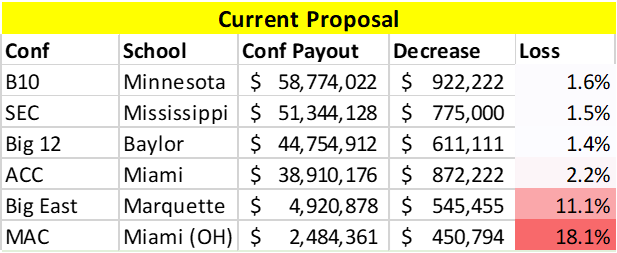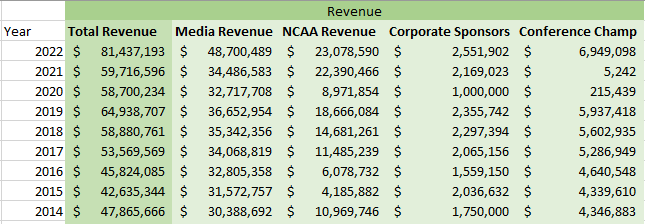There is so much meat on this bone, it’s difficult to know where to start, but for the sake of brevity, just know that there are 3 legal challenges currently circulating in various court systems against the NCAA and its conferences, seeking back pay for all of the years the schools profited off athletes without monetary compensation. And if you know anything about the NCAA in court, it has about as good a chance at winning those cases as DePaul has to win the title.
With this knowledge, there have been talks about proposed settlements to be awarded to the athletes harmed, in exchange for the dissolution of the cases. Yahoo Sports’ Ross Dellenger has had tremendous coverage the past 2 weeks of what has been going on behind the scenes and I highly suggest you read his Twitter feed and click on his stories, because there’s a lot of nuance and detail to this that I’m glossing over.
Part of his reporting impacts the very people that frequent this blog, Marquette and Big East basketball fans. Because as part of the negotiations, the NCAA is proposing the $2.776 billion necessary to pay the settlement be split between the NCAA coffers, and the conferences themselves.
The NCAA will be responsible for 40% ($1.1B) with the other 60% ($1.66B) coming as a reduction in distributions from the NCAA to the conferences over the next 10 years. As a reminder, the NCAA distributes yearly sums to conferences, primarily based on NCAA Tournament performance, and those conferences then pass on the money to individual member schools through yearly payouts.
And the negotiations for that 60% going on behind the scenes spilled into public knowledge over the weekend, when Big East Commissioner Val Ackerman went public with her dissatisfaction to the proposed payment structure.
The structure left the Power 5 (now 4) responsible for 60% of the tab, and the rest of the conferences taking 40%. That sounds fair in theory, but what that means, is that although the Power 4 conferences have larger bills, their bills are a much smaller portion of their overall revenue. But in practice, it’s a huge slap in the face, or swing at the kneecaps, if you want to be more literal about it.
Privatize Profit, Socialize Cost
The way the NCAA went about it, they set up the model based on a 9 year look of distributions to conferences. But there’s a huge disconnect, the NCAA revenue doesn’t include anything from football. The College Football Playoff isn’t run by the NCAA and the money from that completely bypasses the organization. So basically, what the NCAA is doing is ignoring any profit that schools have made from football. Which is insane!
College football is the 2nd most popular sport in the country behind the NFL and the sums that come in are astronomical. The Big Ten just reported over $800M in revenue in FY2023, led in part by new TV contracts featuring football and will soon cross the $1B a year mark. And the logic the NCAA uses doesn’t factor it in. What does that mean in practice?
Schools like Marquette will be forfeiting 12%+ of their yearly revenue from the Big East, while a school like Minnesota will forfeit less than 2%. It’s the same story for all the Power 4 teams. I looked at the 990 tax reports for the following 6 conferences for FY 2022 and located what they distributed to the 6 schools listed. Minnesota got $58.7M from the Big 10. Marquette got $4.9M from the Big East. Then I took the average amount each team will forfeit, based on Dellenger’s reporting, and showed what percent of their annual conference payout that would impact. (Full decrease details in the appendix.)

Once more, this is insane.
Schools like Mississippi and Minnesota won’t notice the rounding error. Schools like Miami of Ohio will see 1/5th of their conference payout disappear. In a gallows humor sort of joke, the ACC will have a significantly larger deduction than the SEC, despite the fact the SEC is set to double the ACC’s total revenue in a few years.
The non-P5 (led by Val) had come up with a more equitable plan (below) that would have have flip flopped the total obligation from 60/40 to 40/60, but NCAA negotiators rejected that plan and went with the original model.

But Why?
Because they can.
It’s as simple as that. We are at a point in time where the NCAA needs the P4 conferences more than the other way around. That’s my opinion, of course, but scenarios like this only prove it. If the NCAA angers Sankey and Petitti and Yormark, there is a real danger they can take their ball and go home. I understand it’s not as easy as saying we’re leaving the NCAA, as the NCAA does a lot more than just put on a basketball tournament, and then there would be lawsuits and anti-trust hearings and a lot of not-fun stuff. But we’ve seen a few proposals leak already, so this isn’t something fans are dreaming up in Discords and Fan Forums.
The NCAA is made up of all members, of course, but if it loses the P4, it would lose the biggest money maker that is the NCAA Tournament, as no way CBS and Turner are paying $1B a year without the North Carolinas and Dukes. So it willingly put forth a proposal that has a tremendous negative impact on non-high-level football schools, while not ruffling any P4 feathers.
Of course, just because one side proposes a settlement in a legal dispute does not mean that settlement will be accepted or legally valid. But the point stands that no matter what the final version ends up being, the brunt of the penalty will be felt not by the schools spending hundreds of millions on football stadium renovations on the backs of the very same football players now suing them. That’s why the P4 will approve the current version with nary a peep.
Big East Details
If you haven’t been around these parts before, I dive into the financial details when the Big East releases new 990 tax filings.
If you didn’t click through, this is the chart that matters for this conversation.

Over a quarter of the conference’s revenue each year comes from the NCAA payouts. The other enormous factor, and the one separating the Big East as a high major in basketball, is the media revenue. In 2022, the Big East received over $48M from its media partners (primarily FOX) for its basketball rights.
The reason I bring this up is because we’ve already established the NCAA is set to dock the Big East about $6 million a year for its portion of the settlement. That’s going to be 1/4th to 1/3rd of the total it normally gets every year for the next 10. It’s a huge penalty.
The conference is about to enter the final season of its 12 year TV contract with FOX in 2025. There are negotiations currently ongoing, and as of 2 months ago, a renewal with FOX “appeared likely” per John Ourand, who is the sports TV contract king.
The figures were not spelled out in the report, so we don’t know what the financials will end up looking like, but an already incredibly important contract for the health of the conference will become even more so thanks to the NCAA settlement.
Appendix

Make a one-time donation
Choose an amount
Or enter a custom amount
Your contribution is appreciated.
Donate
now all the really good players will go to a college to play basketball that gives them the most money. Small colleges like be at huge disadvantage